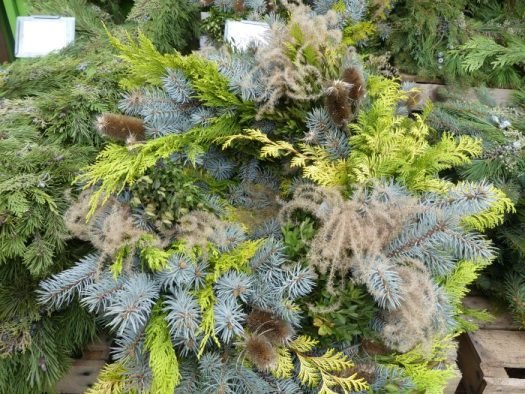Pines are among the most important timber species and are widely used as ornamentals and windbreaks in home landscapes. These native conifers are iconic members of many ecosystems throughout the U.S. However, their prolific growth does not mean they are invincible. If you have a pine in your front or back yard, you may notice that a few diseases can attack the needles and bark, potentially causing major structural and aesthetic problems.
The Pinus genus includes about 100 species of coniferous, mostly evergreen trees and shrubs native to Northern temperate regions throughout the world. Coniferous means cone-bearing, and evergreen means the plants retain their green foliage year-round. The needles and cones are distinctive from broadleaf fruit-bearers, like maples or apples. The timber is considered softwood.
Many common diseases are easily diagnosed from symptoms on the needles and bark. Some have easy cures, while others may require special management. Let’s dig into the 9 diseases to look out for and what you can do to keep your pine tree healthy.
What Disease is Attacking My Pine Tree?
Pine Wilt, Dothistroma Needle Blight, Needle Cast, and White Pine Blister Rust are the most common diseases in the Northern Hemisphere. Pine wilt is caused by a highly destructive nematode that spreads via wood-boring beetles.
The other diseases are caused by fungal pathogens. Key identification symptoms include:
Discolored gray-brown needles and rapidly wilting branches.
Reddish-brown bands on the needles, often bordered by yellow rings.
Older needles curl and turn reddish brown in spring, progressing to grey or tan.
Swollen orange/brown cankers on the trunk and yellow/orange spots on the needles.
It’s important to identify the plant disease before taking action. If you’ve confirmed that Pine Wilt is attacking your tree, it should be removed and burned or chipped immediately. Do not use the chips in your garden to prevent the spread of the disease.
The other diseases are controllable with organic or synthetic fungicides. Some diseases attack other conifers and shrubs, so quick action is necessary to ensure that the pathogen does not spread to neighboring plants.
9 Common Pine Tree Diseases and How to Treat Them
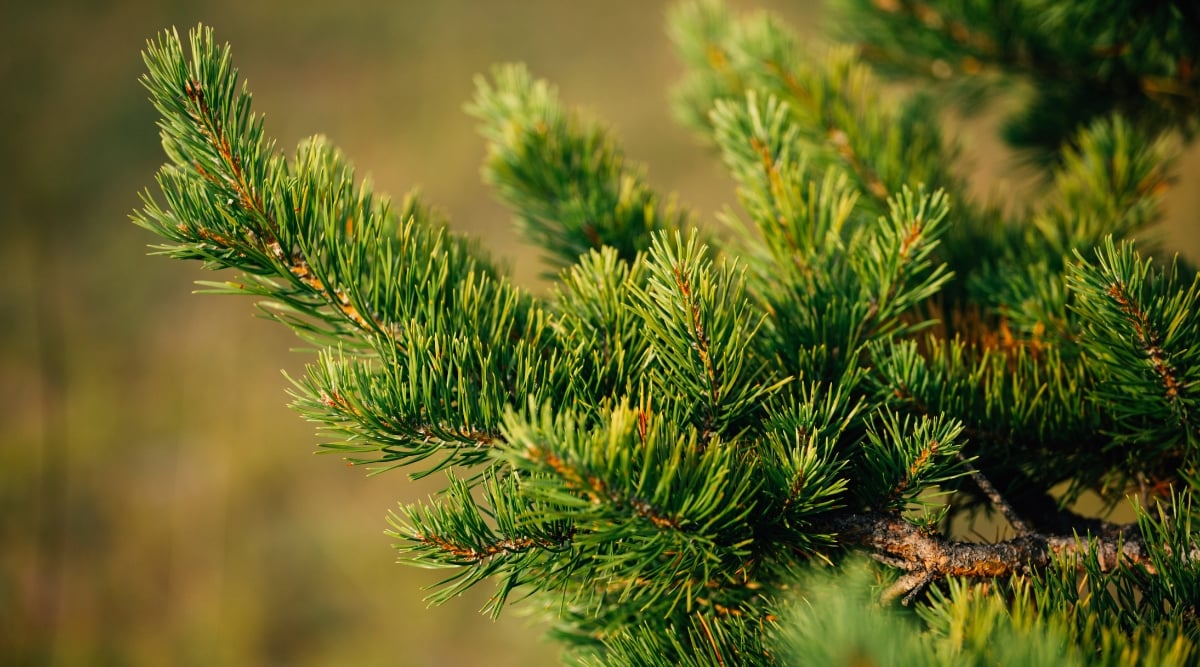
Pines are generally very resilient and adaptable to a range of environments. They dominate northern forests yet still grow well as pollution-tolerant in urban areas. Ponderosa pines are fire-resistant. Bristlecone pines are among the oldest trees on Earth, with one tree in California surviving and estimated 4,800 years.
Still, no plant is invincible. Some diseases can take hold of these evergreens and permanently harm them. Others are preventable and treatable. Here’s how to identify what may be afflicting tree and what to do about it.
Pine Wilt
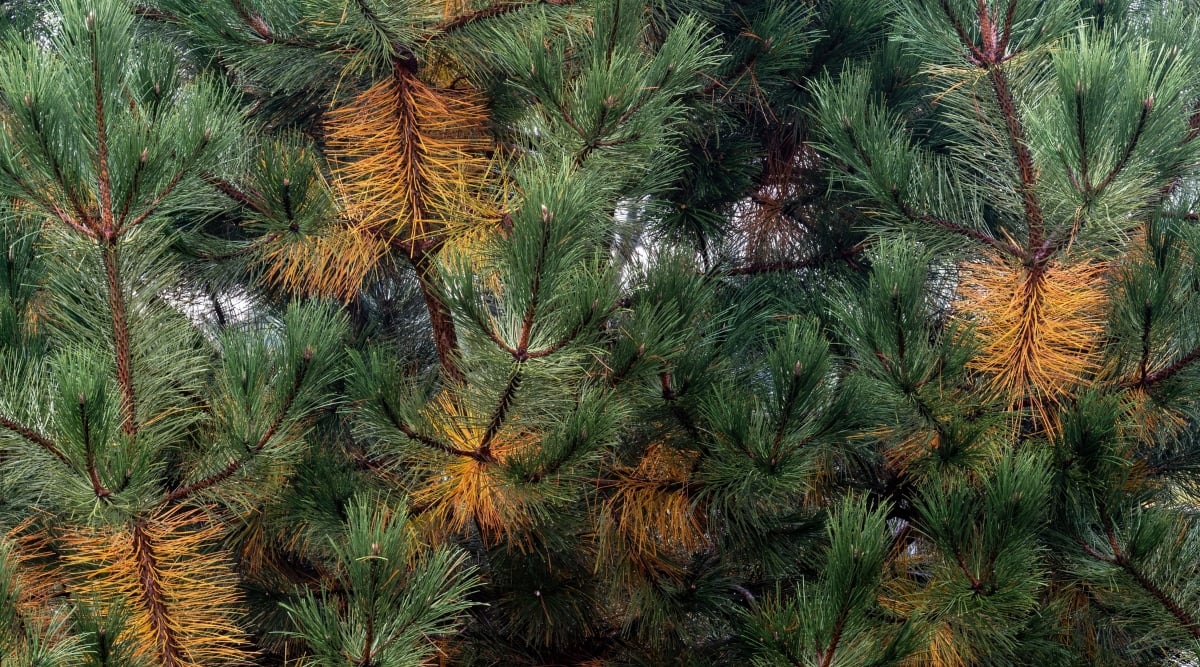
The most common and devastating pine disease in America is Pine Wilt. While most plant pathogens are caused by fungi and bacteria, this disease is caused by nematodes. The pinewood nematode (Bursaphelenchus xylophilus) is the primary culprit.
However, the nematode is typically spread by wood-boring beetles, including sawyers beetles and longhorn beetles. When the beetles infest a tree, they usually bring the nematodes with them. After these two species attack the tree, harmful fungi typically spread throughout the tissues, leading to the characteristic blue stain pine lumber caused by Pine Wilt.
Fortunately, pinewood nematodes primarily attack weakened trees or exotic and non-native pines. Planting a species endemic to your region reduces the risk of this disease.
While most nematodes attack plants from the roots, the pinewood nematode is a microscopic roundworm that attacks the above-ground parts of the tree. The needles will be clearly yellow, brown, and dying. The effects will be concentrated around a cluster of branches and slowly spread to other foliage.
Key signs of Pine Wilt include:
| Discolored needles | The first sign is greenish-gray needles that turn yellow and brown. |
| Clusters of dead branches | The nematode starts in concentrated areas of the canopy. |
| Spread to the entire tree | Over time, the whole tree will turn brown and die. |
| Permanent wilting | An overall drooped appearance, no matter how much water is present. |
| Lack of sap | Most conifers exude resinous sap when a branch or trunk is cut, but infected trees won’t have sap because the nematode attacks the vascular system. |
| Blue stain | When the wood is cut, it usually has blue-speckled fungal stains. |
The bad news is that Pine Wilt is incurable. The good news is that it usually isn’t a problem in North American native species. If you avoid growing exotic or non-native pines in your landscape, you can usually avoid this disease altogether. Search your local Forest Service or University Extension website for native pine species recommendations.
Infected trees should be removed and chipped or burned to prevent the spread of the disease. Stumps must be removed or ground to below the soil surface. This wilt can also infect Douglas fir, larch, fir, spruce, and cedar. Fortunately, other species are less susceptible to damage or death. Still, it’s best to remove them and replace them with healthy native pine species.
Dothistroma Needle Blight (Red-Band Needle Blight)
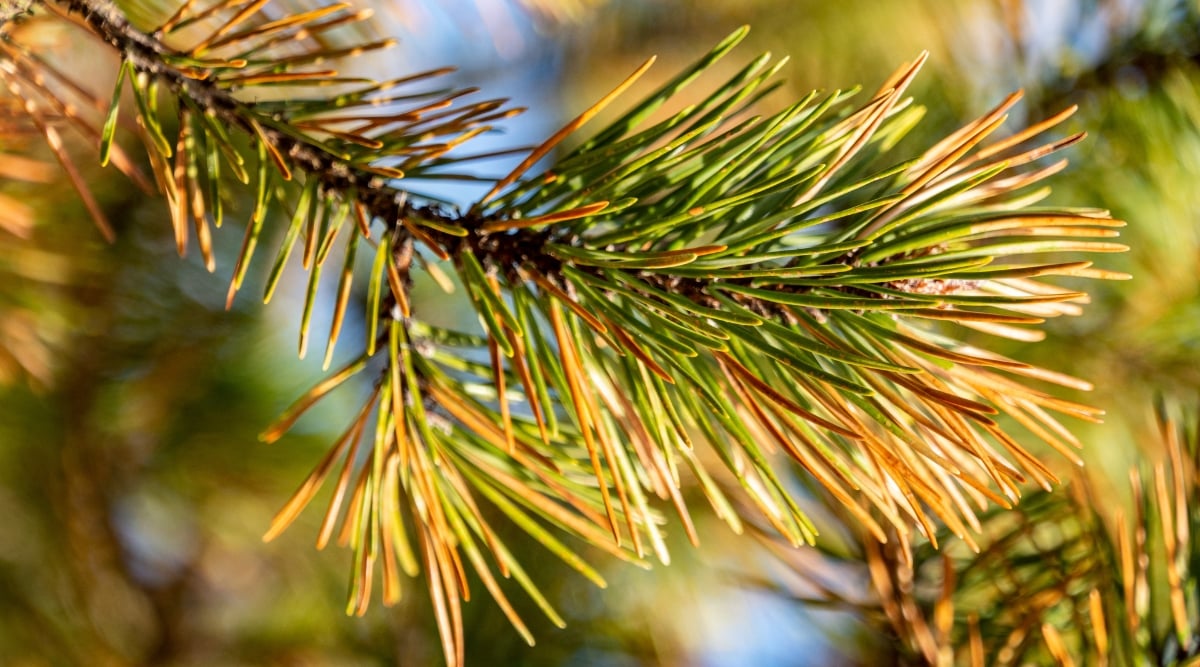
Red-Band Needle Blight is caused by the fungus Dothistroma septosporum. The common name refers to the most obvious symptom of yellow and tan bands along the needles that eventually turn red. The ends and centers of the needles look reddish-brown while the rest of the foliage remains green.
This pathogen primarily affects the Central and Eastern United States, as well as some parts of Southern Alaska. It also exists in New Zealand, Tanzania, and parts of Europe. The blight most commonly attacks Austrian (Pinus nigra), Lodgepole (P. contorta), and Ponderosa pine (P. ponderosa).
Fortunately, Red-Band Needle Blight spreads relatively slowly. The fungus requires over one full year to complete its reproductive cycle, so it is less likely to become a serious problem in established pines. Cool, wet weather is necessary for the fungus to spread.
Red bands on needles are clear signs of blight infection. You may also notice:
- Reddish brown spots on needles
- Needle spots expand, and then girdle the base of the needle
- Tiny black spots or bands indicate fungal fruiting bodies on the needles
- Infected needles eventually turn brown and fall, leaving bare branches
Copper fungicides are the most common treatment option for this plant. They can protect new growth from fungal infection if applied in the spring before tree buds open and again in mid-summer as the needles develop. Be sure to carefully read the label and avoid overapplying.
Fortunately, there are also many preventative strategies, including:
| Air circulation | Avoid overcrowding in the landscape. |
| Pruning | Remove bottom branches to increase air flow. |
| Weeding and mulching | Removing weeds and mulching 3-4 inches of wood chips prevents fungal growth. Avoid mounding mulch too close to the trunk. |
| Avoid sprinkler irrigation | Reduce the amount of water on tree needles |
| Grow resistant species | Red pine (P. resinosa) and Scots pine (P. sylvestris) are resistant to the disease. |
Pitch Canker
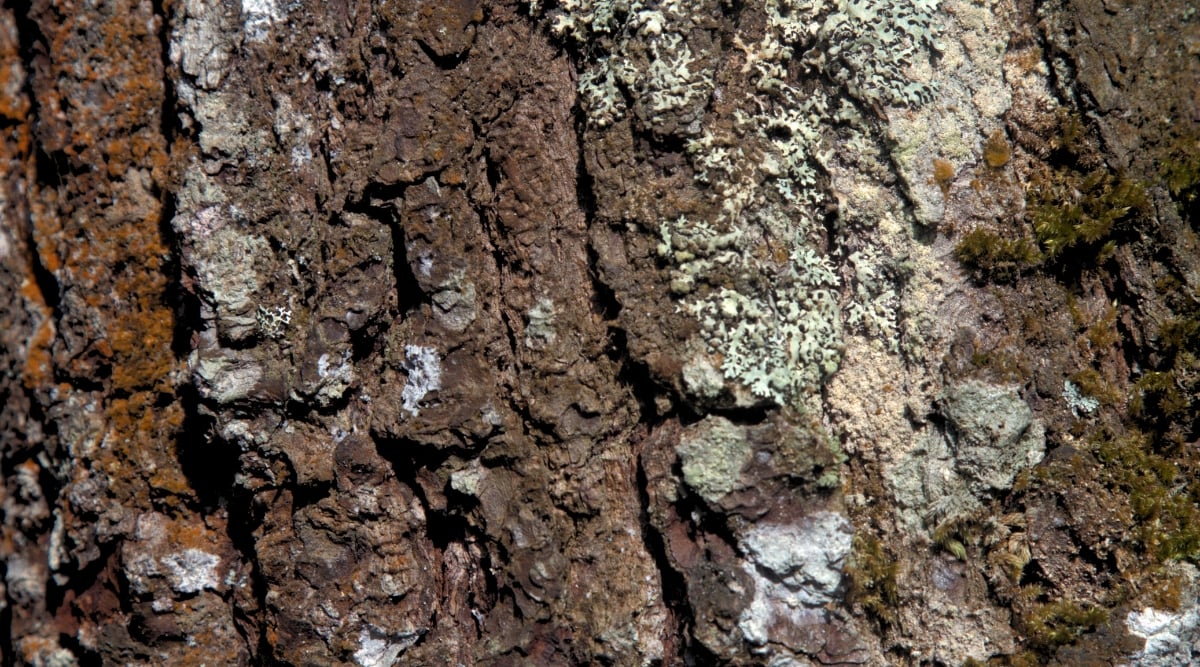
Caused by Fusarium lateritium, Pitch Canker is another fungal enemy. Luckily, this one is easier to avoid with cultural control. The pathogen mostly targets trees that are damaged, so if you prevent damage to your tree, it is unlikely to succumb to Pitch Canker.
This fungus enters through wounds. Insect feeding, fallen branches, and mechanical injuries (like hitting with a lawn mower or using unsharpened loppers) are the most common causes of tree wounds.
The fungus infects the exposed tissue and causes lesions in the bark, leading to excessive amounts of resin production. The resin depletes the tree’s nutrient stores and can cause whole shoot dieback. You will know if Pitch Canker has attacked your tree because the gaping wounds are obvious sores in the landscape.
Pine Pitch Canker looks like:
- Trunk cankers or wounds that leak thick whitish-yellow resin
- Unusual amounts of resin around bark lesions
- Whole twigs or branches dying
- Red, brown, or yellow-pale needles
- Young seedlings die from the base first
- Top leading branch turns black and curled
In extreme cases, the lesions caused by Pitch Canker can girdle branches or stems, and they may fall off from the base.
There is no real cure for Pitch Canker. Fortunately, pine species can usually live for a long time with moderate symptoms. However, large dead limbs or giant lesions on the trunk can kill the tree, especially if there is a secondary infestation of bark beetles.
The best form of prevention is to prevent tree wounding. If you are pruning, always use sharp, sanitized tools to ensure clean cuts. Prune in late winter and early spring to ensure the new growth can conceal wounds. Avoid damaging the bark or trunk of the tree with machinery or other knicks and scrapes.
Monterey pines (P. radiata) in California are extremely susceptible to this disease, but Loblolly (P. taeda) and Eastern White (P. strobus) are more resistant.
Diplodia Tip Blight
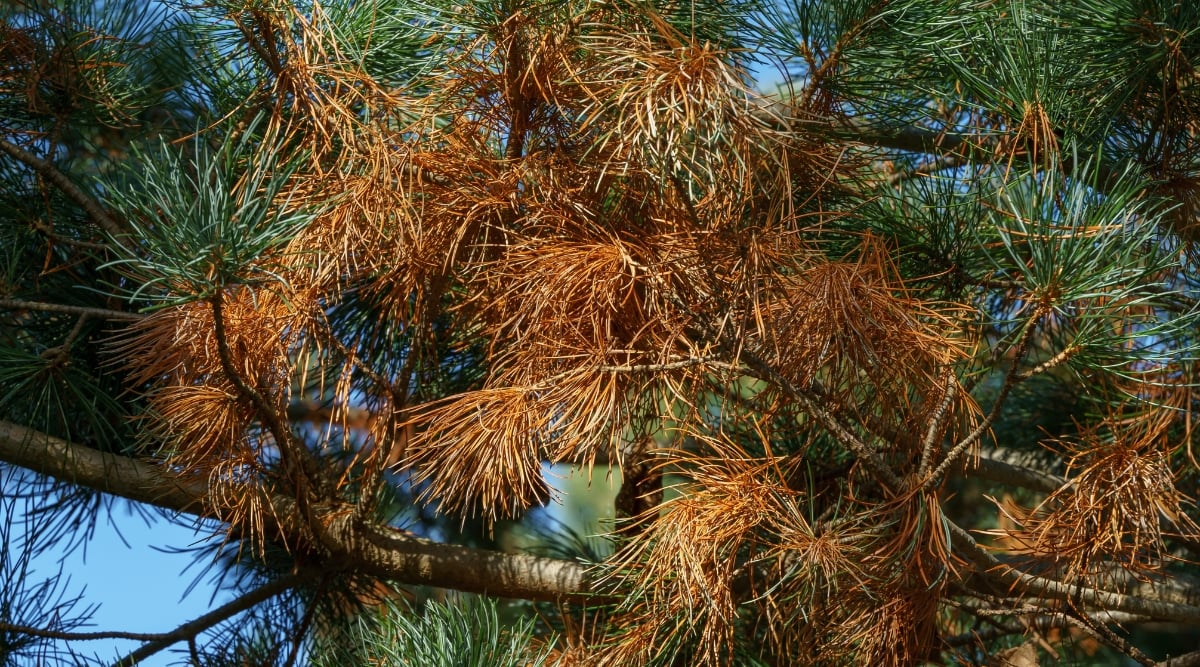
This common fungal disease affects pines that grow their needles in bunches of twos or threes. Susceptible species include:
- Austrian pine (P. nigra)
- Scots pine (P. sylvestris)
- Red pine (P. resinosa)
- Mugo pine (P. mugo)
- Ponderosa pine (P. ponderosa)
Tip Blight mostly affects older trees. Moderate damage can occur on 15-20 year old specimens, and extreme damage can affect those older than 30 years. The disease is most common in landscapes where they become stressed by pollution, compacted soils, concrete, mechanical wounding, hail, or insect infestations. It is rare in native forests.
The most obvious signs of Diplodia Tip Blight include:
- Needles at the tips of the branches die back
- The new growth of needles is stunted and turns yellow, tan, or brown
- Symptoms begin on the lower part of the tree and slowly extend upward to the top
- In summer, black dots (fungal fruiting bodies) appear under the needles
- Cankers can occur on the bark and kill whole branches
The best way to prevent Tip Blight is to maintain tree health and avoid wounding. This fungus targets stressed pines. If you plant native varieties and care for them properly, it is unlikely to be an issue. Remember to:
- Avoid pruning in the spring or summer, as they are most vulnerable to infection during this time. Remove diseased plant parts as soon as it is dry enough in fall.
- Remove and destroy dead cones and branches from the base, especially if infected.
- Sanitize and sharpen pruning tools.
- Avoid mechanical injury to tree trunks.
- Water your pine during prolonged droughts.
Fungicides can be used for these aggressive infections, but they must be applied in early spring before bud break. Organic-approved copper fungicides are an option. Closely follow package instructions.
Pine Needle Rust
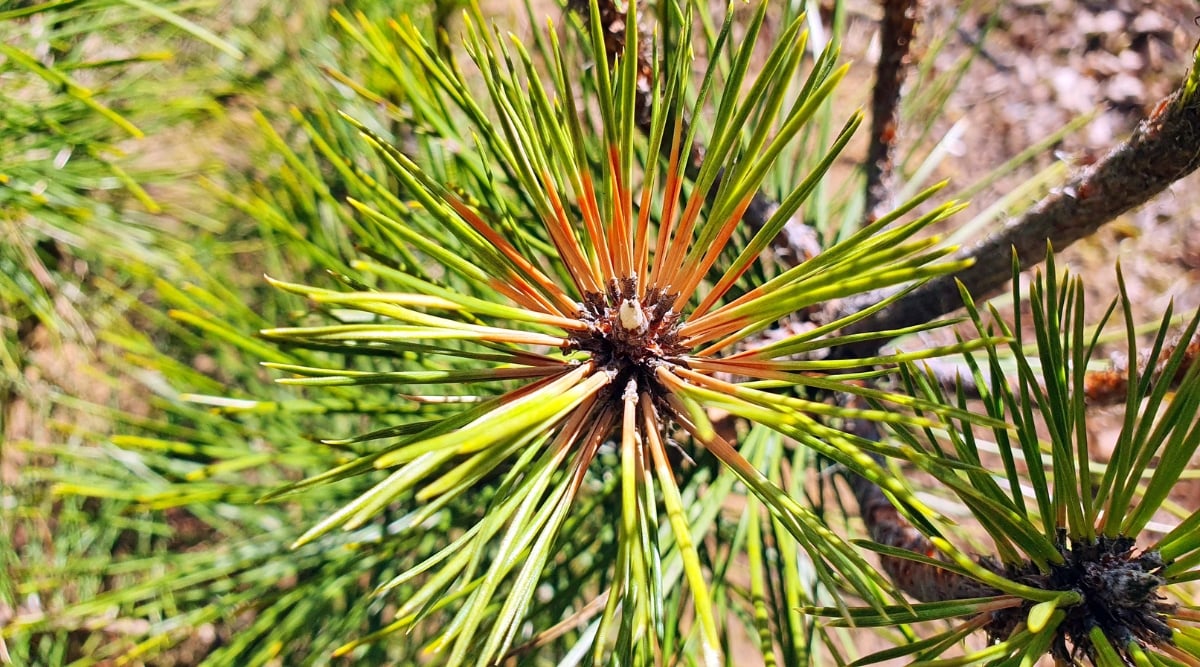
This disease is named for the rusty appearance of infected needles. Like Tip Blight, it occurs in species with bundles of two or three needles. These bundles are called fascicles, and they are often used to distinguish between different species of pine.
This disease differs from Tip Blight in that it affects young pines. Needle rust is most commonly seen on small trees growing near goldenrod. This is because the causal Coleosporium fungi requires a plant from the aster (Asteraceae) family to complete its life cycle.
Wild goldenrod plants (as well as daisy fleabane and goldenaster) act as secondary hosts for the fungus. The spores spread throughout the growing season, but especially in the fall in moist Eastern climates. The spores can also overwinter on the goldenrod and spread in the humid or windy weather of spring.
You will immediately notice Pine Needle Rust by:
- Yellowish-orange spots or bands on new needles
- Very bright yellow foliage appearance
- Raised white tubes growing on needles eventually burst with powdery orange spores
- Lower branches are very yellow or dead
- Goldenrod plants may have yellow spots on the upper surface and raised orange dots on the lower leaf surfaces
Fortunately, this disease is only a minor issue for mature pines. It can be very harmful to young pines and cause stunted growth. However, the easiest way to prevent the infection is to prevent tree stress.
To prevent Pine Needle Rust:
- Sufficiently water young plants during drought
- Apply organic bark mulch at the base
- Remove aster, goldenrod, and aster-family flowers from the area
If you like to grow a lot of aster-family flowers in your landscape, opt for White Pine (P. strobus), which is resistant to Needle Rust.
Fusiform Rust
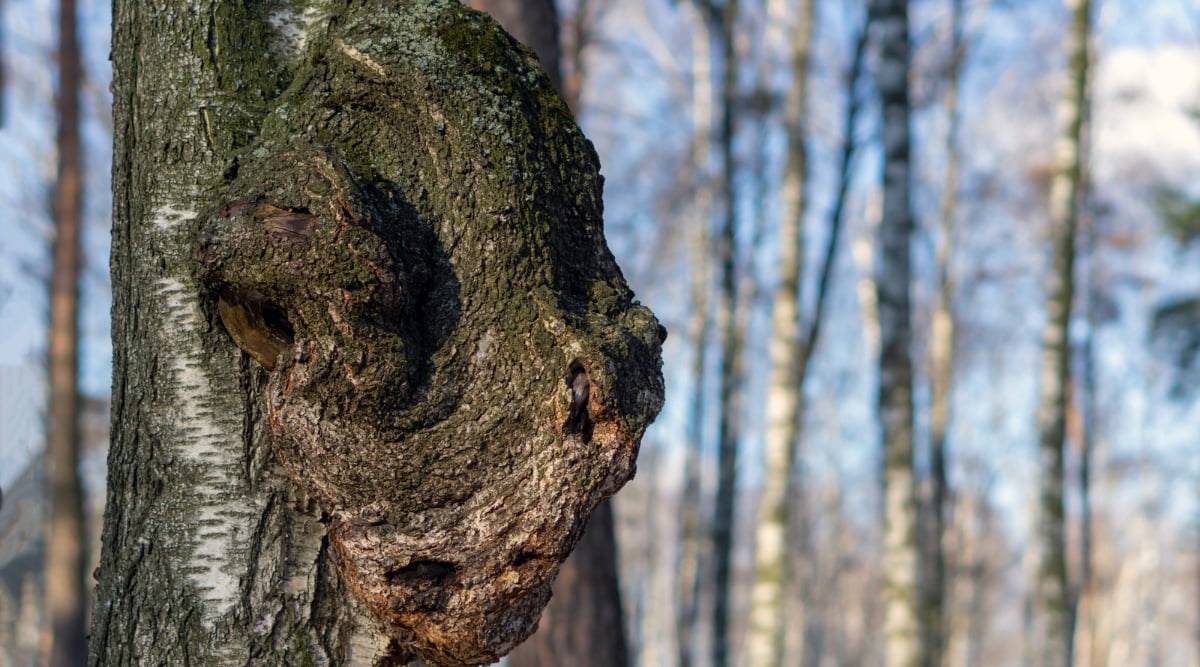
This disease is one of the most common and damaging forest diseases in the South. The fungus hops between its alternate host—oak—then back to pine. It spreads rapidly in windy, densely planted areas. Loblollies and slash pines (P. elliottii) in the Southeast are particularly vulnerable.
The most important time to catch this infection is in young saplings. The rust will kill the three within a few years, so you must be very careful if purchasing seedlings from a nursery where they were potentially infected. Closely inspect branches for signs of symptoms before purchasing nursery saplings.
Fusiform rust has a rusty appearance that is very noticeable. The symptoms include:
- Large galls or spherical swellings on the trunk, main branches, or seedling stems.
- Orange spores cover the galls in the spring.
- Branches and twigs may grow abnormally like brooms from a single point on the tree.
- Nearby oaks may have the orange-spored galls on the undersides of their lives.
- Galls and cankers can cause whole branches to become girdled and fall off.
This complex fungal disease is difficult to control because it has multiple hosts. Prevention is key. If you have noticed this disease in your area, it’s best to avoid growing Loblolly pine and instead plant other natives like longleaf pine (P. palustris).
Annosus Root Rot
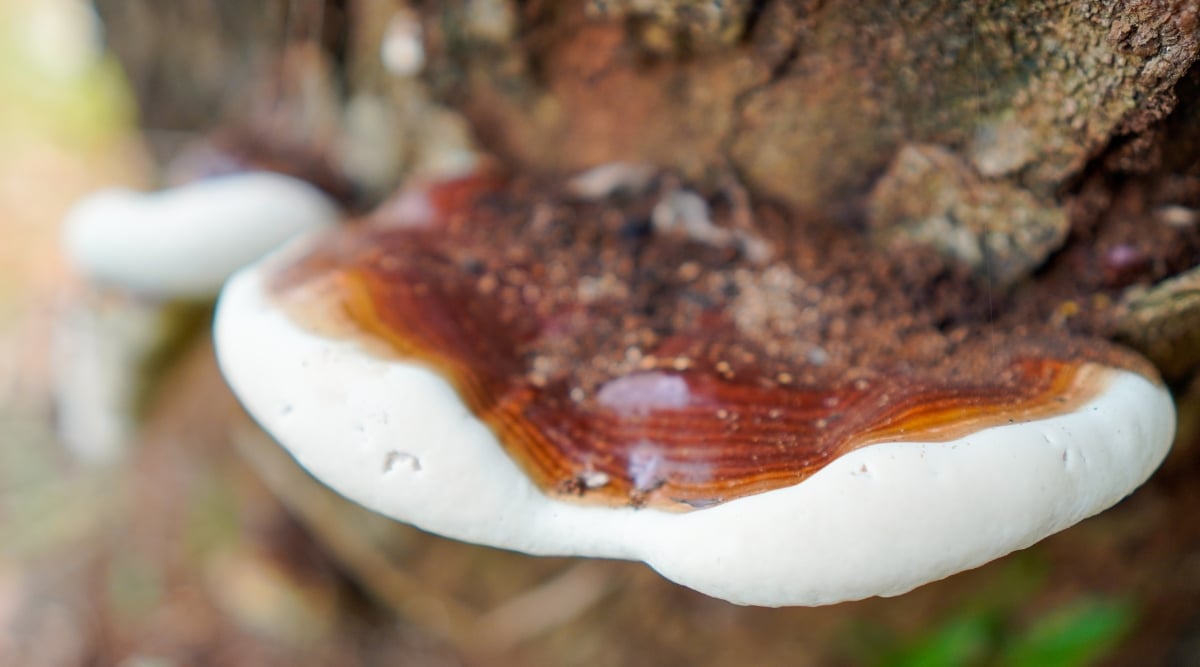
Root rot is another common disease of conifers in the South and Southeast. Again, Loblolly and slash pine are the most vulnerable. This disease is easier to prevent because it primarily enters the tree through large wounds. The fungus Heterobasidion annosum grows into the center of the tree and begins decaying the root system.
Unlike other pathogens on this list, the Annosus Root Rot (ARR) fungus actually produces a mushroom on the outside of the tree. The mushroom looks like a tannish-brown conk at the base of dead or dying trees and stumps. Not every infected tree will grow a conk.
Another strange thing about this root rot is that it’s not actually linked to waterlogged soils. We usually associate root rot with poorly drained soil. However, Annosus Root rot usually attacks pines growing in sandy soils.
Mushroom conks are the most noticeable signs of ARR, but these symptoms are also easy to identify:
- Large brownish-tan conk mushrooms at the base of the tree
- High resin flow near the collar (base) of tree
- Large clusters of dead or dying pines in a landscape forest
- Stringy roots or lower wood with white rot
- Off-color needles in the crown of the tree
- Heavy infestation of pine beetles or bark beetles
- Leaning or blown-over trees (from lack of root support)
If you cannot see a visible mushroom but still suspect something is wrong with your pine, a local extension office can usually diagnose this fungus with basic laboratory equipment.
It’s very important to remove infected stumps or woodfall to prevent this pathogen from spreading. Borax is a reliable preventative method applied to stumps. Biocontrol fungi like Phlebiopsis gigantea can also be used to colonize the wood and attack the pathogen fungus. This fungal warfare requires purchasing spores from a reputable source.
You can also avoid susceptible species like loblolly. Firs and spruces are better options in areas prone to ARR.
White Pine Blister Rust
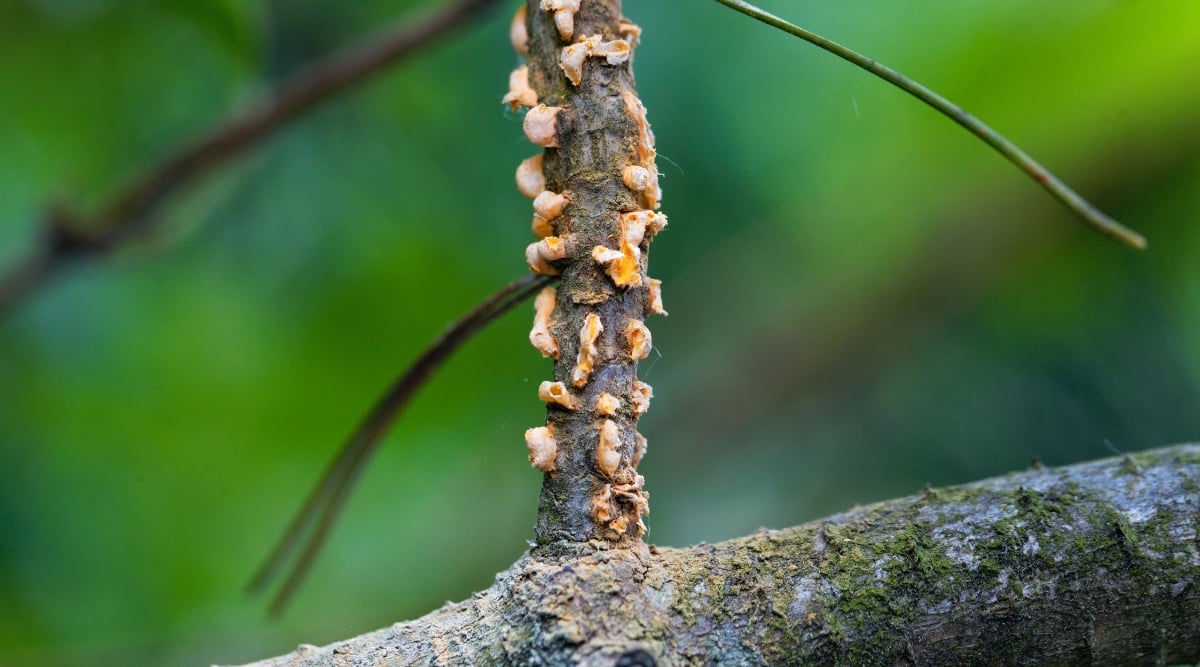
Midwestern and Eastern gardeners must be very aware of White Pine Blister Rust. As the name implies, this disease primarily attacks white pine (P. strobus) but it can spread to other five-needle species, and to understory plants like gooseberry (Ribes spp.) plants and Indian paintbrush (Castilleja spp.).
The rust may be fatal, beginning with damage to the tops and branches. It favors cool, moist northern climates and tends to attack in the late summer.
White Pine Blister Rust is easy to recognize by these symptoms:
- An entire branch of needles turns yellow then rusty-red
- Infected branches have swollen cankers with cracked, discolored bark
- Main trunk cankers are shaped like ovals or diamonds
- Sticky white or clear resinous sap oozes from the cankers
- White or yellow blisters form at the edges of cankers in the spring
- Orange powdery spores and gummy orange droplets form near cankers in summer
Neighboring gooseberry plants may have:
- Yellow angular leaf spots
- Raised orange globs under the leaf spots
- Hair-like tendrils from the orange globs
- Lots of fallen leaves and dead branches in the middle of the season
The best way to control this disease is to prune off diseased branches as soon as you notice them. The fungus cannot survive on dead wood. Use sharp, sanitized shears to cleanly cut away infected branches where they meet the trunk. Remove an extra four to six inches of healthy wood behind the visible canker to ensure the fungus is removed.
Burn any infected materials and thoroughly sanitize your tools and clothes. It’s also helpful to remove gooseberry and paintbrush hosts because they can become reservoirs for spores.
Needle Cast
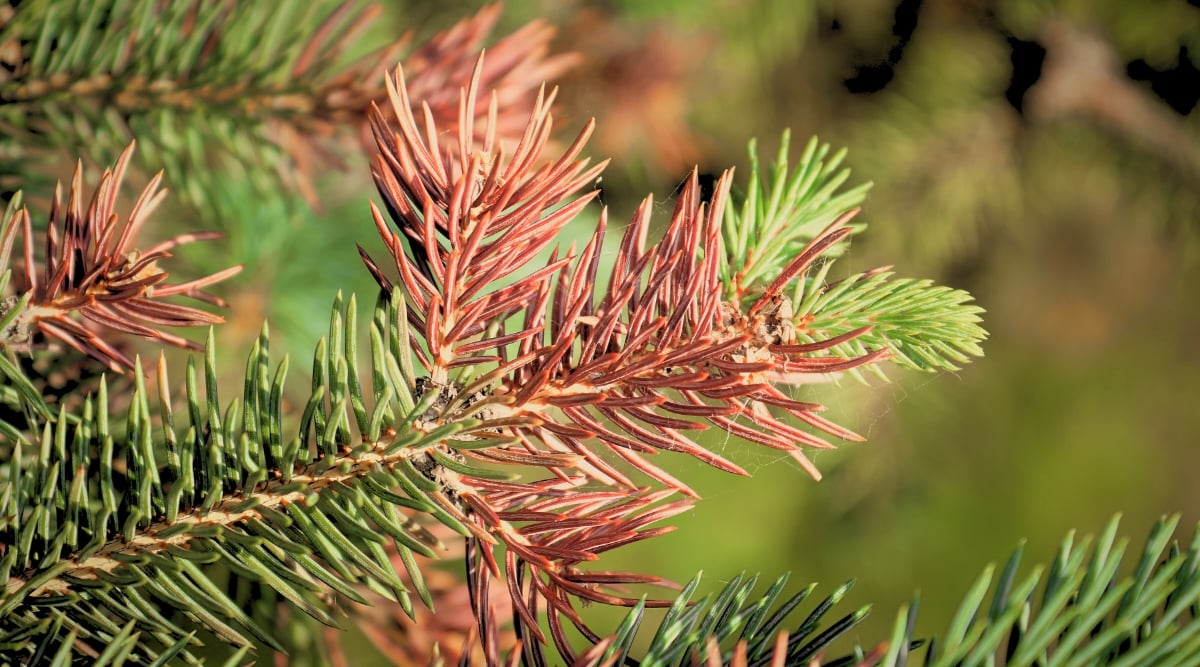
Sparse or ragged growth is often infected by some sort of Needle Cast. This disease name is used for several fungi that cause similar symptoms. The needles turn yellow or brown and fall prematurely. This shedding or “casting” of needles makes the tree look spindly or bare in many areas. Sometimes, the symptoms aren’t noticeable until the next spring or winter after infection.
Needle Cast is most common in the South, Southeast, and Great Lakes areas of the U.S. It primarily attacks longleaf (P. palustris) and Scots pines (P. sylvestris). In the northern Rocky Mountains and South Dakota’s Black Hills, another type of Needle Cast fungus sometimes attacks ponderosas. Fortunately, the disease is less common in dryer, low-elevation urban areas of the West. The fungi are most prominent in humid eastern climates.
Needle cast is most noticeable by the sparse tree appearance. You can also look for:
- Clusters of yellowish-tan needles
- Infected needles turn reddish-brown later in the summer, but the bases stay green
- Light green to yellowish spots on needles
- Whitish or black fungal fruiting bodies and spores are visible in wet weather
- Large segments of dead branches
Copper fungicides are the main treatment for this disease, but it is technically incurable. The copper prevents further infection and must be applied regularly. Raking and burning fallen needles can help with control. Never prune in wet weather. You may need to replace infected or dying young saplings with disease-tolerant species like cedar or fir.
Key Takeaways
Most diseases are caused by fungal pathogens that attack in cool, moist weather. It’s important to plant regionally-native pines and regularly inspect them for signs of infection. Other important tips for disease control include:
- Minimize mechanical or pruning damage because most fungi enter the tree through wounds.
- Never prune during wet weather or in mid-summer.
- Avoid using sprinklers nearby.
- Keep your trees healthy and less stressed by watering during drought.
- Sanitize and sharpen tools consistently.
- Clean up fallen debris from the base.
- Use copper fungicides to prevent further infections.




